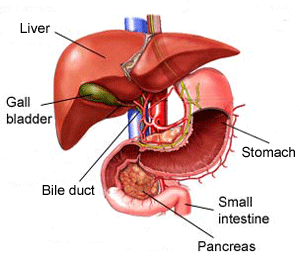Liver

The liver is a vital organ in all Vertebrates as well as some Invertebrates (e.g. octopuses and other cephalopods). It is both the largest solid organ and the largest gland within the human body, weighing ~1.8 kg in men and 1.3 kg in women [1]. It plays a vital role in metabolism and has a wide range of functions within the body, including glycogen storage, detoxification and bile production.
This organ has remarkable regenerative abilities which allows surgeons to perform liver transplants where the donor is still alive. The liver is approximately halved during the surgery and within 4-8 weeks it should have grown back to it's normal size[2]. This ability also means that, in transplantations where the donor is deceased, there is a possibility that it can be given to two patients rather than the one.
Anatomy
The liver is reddish brown in colour and is divided into two main lobes which are further seperated into thousands of smaller lobules. The majority of the liver is made up of hepatocytes which are involved in the metabolism of drugs, for example paracetamol via the CYTp450 enzyme.